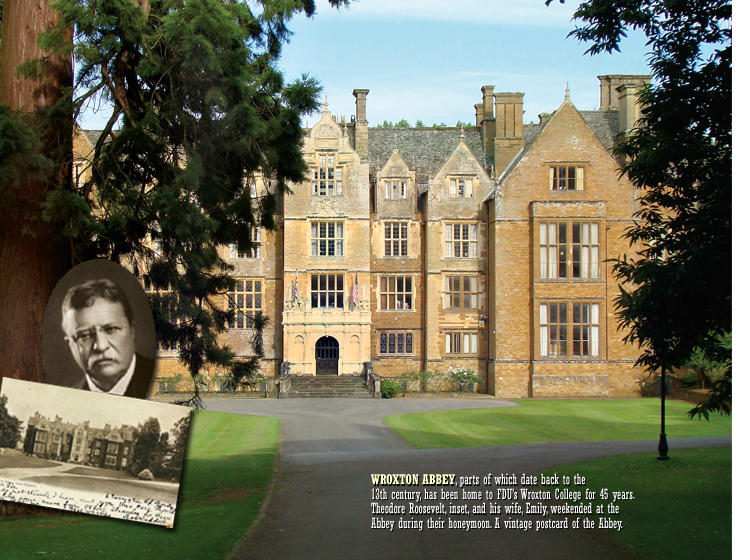
FDU ranks high among veteran-friendly schools. Several veterans of Iraq and Afghanistan tell how the University is helping them build new lives.
Join Dean Nicholas Baldwin as he reflects on his 25 years as head of FDU's first international campus, Wroxton College.
Bruce Springsteen and poet Robert Pinsky headline WAMFEST: The Words and Music Festival at the College at Florham.
Psychology professor Katharine Loeb looks at eating disorders and pediatric obesity and how parents may hold the key to treatment.
Service opportunities make Spring Break rewarding and educational for student volunteers.Alumni Profile
The Jokes Are on Them!
Arlene, BA'68 (T), and Harlan Jamison, BA'68 (T)Alumni Profile
A Portrait in Public Service
Harold “Cap” Hollenbeck, BA'61 (R)



Forty-five years ago, FDU became the first American university to own and operate a campus in the United Kingdom. “In today’s interdependent, global environment, the decision to purchase such a campus may not seem all that unusual,” says Wroxton College Dean Nicholas Baldwin, “but back in 1965 it was a unique, farsighted initiative; one that set the focus — and vision — of the University beyond New Jersey and the United States.” In this account, Baldwin reflects on his 25-year tenure at Wroxton.

How does one even begin to attempt to sum up a place like Wroxton? It is a difficult task, particularly when it has played such an important part in one’s life — and has done so for a substantial part of one’s life. There is always so much one could write — so self-discipline will have to be vital! Let’s break it down and look at things under three distinct headings, namely, the place, the programs and the people.


The Wroxton Abbey estate is historic, beautiful and quite simply unique. The college is housed in a remarkably beautiful, fully modernized, 17th-century country mansion set on 56 acres of lawns, lakes and woodlands in the heart of England. In the past, the college — then a private house — was home to the North family, including such prominent historical figures as Francis North, the first Baron Guilford and the Lord Chancellor to King Charles II, and Lord North, between 1770 and 1782 prime minister to King George III and the man more commonly known in England as ‘the man who lost the colonies.’ The Abbey has also played host to royalty — King James I, King Charles I, King George IV and King William IV — and statesmen — including President Theodore Roosevelt, Prime Minister Harold Wilson, Taoiseach Dr. Garrett Fitzgerald and Deputy Prime Ministers Michael Heseltine and Geoffrey Howe. Other distinguished visitors have included Horace Walpole, Celia Fiennes, Henry James and Dame Judi Dench. To Henry James, Wroxton was part of the essence of England:
“Everything that in the material line can render life noble and charming has been gathered into it with a profusion which makes the whole place a monument of past opportunity.”
It still is. At Wroxton, the past permeates the atmosphere and reaches out across the ages and generations through to those at the college today. Indeed, I clearly remember how I felt when I first saw the Abbey. I was in awe of the building; it is strikingly beautiful — I had to pinch myself to make sure I was awake and had not walked into a dream!
When I arrived in 1984, the Abbey consisted of 40 bedrooms and eight bathrooms; it was always interesting when everyone was all seeking to get ready at the same time — for an evening out at the theatre for example! During the latter part of the 1980s, we restructured the arrangements and upgraded the facilities so that, since that time, the Abbey has contained 45 bedrooms, each with its own bathroom facilities.
Bringing new educational tools and technologies to the Abbey has been an interesting experience, not least of all because of the fact that the Abbey is a Grade I listed building — the highest grade historical monument you can get — so that permission needed to be sought (and obtained) in order to be allowed to do anything. I am glad to have had the experience of having done all of this — but would be quite happy never to have to do such a major project again! On the other hand, having responsibility for a building of which the oldest part dates back to 1217 — and the surrounding estate — means that there is never a dull moment (nor ever a time when something doesn’t have to be done!).
About the Author
FDU Magazine Home | FDU Home | MyFDU.net
FDU NOW: The Campaign for Fairleigh Dickinson University
FDU Magazine is published twice yearly by the Office of Communications and Marketing, Fairleigh Dickinson University, 1000 River Road, H-DH3-14, Teaneck, N.J. 07666.
FDU Magazine welcomes your comments. E-mail Rebecca Maxon, editor, at maxon@fdu.edu.
J. Michael Adams, President; Richard Reiss, Senior Vice President for University Advancement; Angelo Carfagna, Assistant Vice President for University Advancement and Communications; Okang McBride, Director of Alumni Relations; Carol Kuzen Black, Director of Publications/Senior Editor; Rebecca Maxon, Editor and Web Designer; Nina Ovryn, Art Director
Contributors: Nicholas Baldwin, Scott Giglio, Katharine Loeb, Andrew McKay, Tom Nugent, Melissa Payton
Photo/Illustration Credits: David Brabyn, Peter Byron, Benoit Cortet, Gerard DuBois, Jaclyn Chua, Danielle Drombar, John Emerson, ETH-Bibliothek Zurich Image Archive, William Kennedy, Dan Landau, Library of Congress, Librarything, Caroline Malia, Craig Mourton, National Portrait Gallery, Art Petrosemolo, Nick Romanenko, Anassa Tullouch
For a print copy of FDU Magazine, featuring these and other stories, contact Rebecca Maxon, editor, at maxon@fdu.edu.
To update your address e-mail fine@fdu.edu or update your profile online at www.MyFDU.net.
©Copyright 2010 Fairleigh Dickinson University. All rights reserved.



